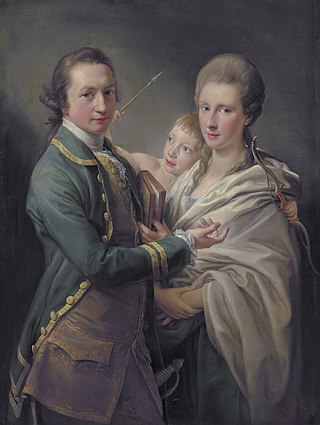
Charles Stanley Monck, 4th Viscount Monck was a British politician who served as the last governor-general of the Province of Canada and the first Governor General of Canada after Canadian Confederation.

Robert Molesworth, 1st Viscount Molesworth, PC (Ire) was an Anglo-Irish politician, peer and writer.
John Forster was an Irish lawyer, politician and judge.
William Power Keating Trench, 1st Earl of Clancarty was an Irish aristocrat and politician and later United Kingdom statesman at the time of the Act of Union. His family, through his son Richard, became prominent and hereditary members of the Netherlands' nobility.

Charles William Wentworth Fitzwilliam, 5th Earl Fitzwilliam in the peerage of Ireland, and 3rd Earl Fitzwilliam in the peerage of Great Britain, was a British nobleman and politician. He was president three times of the Royal Statistical Society in 1838–1840, 1847–1849, and 1853–1855; and president of the British Association for the Advancement of Science in its inaugural year (1831–2).
Henry Tichborne, 1st Baron Ferrard, known as Sir Henry Tichborne, Bt, between 1697 and 1715, was an Irish peer.

George de la Poer Beresford, 1st Marquess of Waterford, KP, PC (Ire), styled Earl of Tyrone from 1763 to 1789, was an Anglo-Irish politician.

John Brownlow, 1st Viscount Tyrconnel, KB, known as Sir John Brownlow, 5th Baronet, from 1701 to 1718, of Belton House near Grantham in Lincolnshire, was a British politician who sat in the House of Commons from 1713 to 1741.

Arthur Saunders Gore, 2nd Earl of Arran, KP, PC (Ire), styled The Honourable Arthur Gore from 1758 to 1762 and Viscount Sudley from 1762 to 1773, was an Irish peer and politician.
Henry Stanley Monck, 1st Earl of Rathdowne and 2nd Viscount Monck, was the son of Charles Monck, 1st Viscount Monck, and Anne Quin. On 28 July 1806, he married Lady Frances Mary Trench, daughter of William Trench, 1st Earl of Clancarty, and his wife Anne, Countess of Clancarty. They had 11 daughters.

Marcus Beresford, 1st Earl of Tyrone, known as Sir Marcus Beresford, 4th Baronet, until 1720 and subsequently as The Viscount Tyrone until 1746, was an Anglo-Irish peer and politician.
Charles Joseph Kelly Monck, 3rd Viscount Monck and 3rd Baron Monck (1797) of Ballytrammon, County Wexford, in the Peerage of Ireland, succeeded to his titles on the death of his brother, Henry. He was the son of Charles Monck, 1st Viscount Monck, and Anne Quin. While his brother's earldom became extinct, the viscountcy devolved upon Charles. On 29 November 1817, he married Bridget Willington, the daughter of John Willington of Killoskehan Castle, Barnane, and Bridget Butler, the daughter of Theobald Butler of Knocka Castle, Drom, County Tipperary.
Sir William Parsons, 1st Baronet of Bellamont, PC (Ire), was known as a "land-hunter" expropriating land from owners whose titles were deemed defective. He also served as Surveyor General of Ireland and was an undertaker in several plantations. He governed Ireland as joint Lord Justice of Ireland from February 1640 to April 1643 during the Irish rebellion of 1641 and the beginning of the Irish Confederate War.
Henry Quin M.D. was an Irish physician in Dublin, Ireland.
Henry Joseph Monk Mason was an Irish writer who, although not a native speaker, specialised in Irish-language activities. He was a founder of The Irish Society, dedicated to spreading the Scripture in Irish, and a campaigner for prison reform.

Grangegorman is an inner suburb on the northside of Dublin city, Ireland. The area is administered by Dublin City Council. It was best known for decades as the location of St Brendan's Hospital, which was the main psychiatric hospital serving the greater Dublin region. As of 2020, the area is the subject of a major redevelopment plan, running for more than a decade, under the aegis of the Grangegorman Development Agency, including the new Technological University Dublin campus.
Price Hartstonge (1692–1744) was an Anglo-Irish politician who sat in the Irish House of Commons as MP for Charleville from 1727–44.
Thomas FitzWilliam, 1st Viscount Fitzwilliam (1581–1650) was an Irish nobleman of the Stuart age. He was born to wealth and privilege, and acquired a peerage, but due to his loyalty to the English Crown, he suffered considerable hardship during the English Civil War, and died in poverty.
Sir John Blennerhassett was an English-born judge and politician who became Chief Baron of the Irish Exchequer and sat in the Irish House of Commons as MP for Belfast. He was a member of a prominent Norfolk family which acquired large estates in Ireland, mainly in County Fermanagh. The Blennerhassett family have an enduring connection with County Kerry.
Sir Henry Harington of Bagworth and Baltinglass, English and Irish landowner and soldier, known for his defeat at Arklow in 1599.







